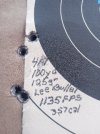johnnyjr
Well-Known Member
So now that I'm basically going to be shooting 38/357 for awhile my question is what bhn, would you more experienced recommend. This will be for my 686 6inch revolver. I have a green dot sight on it.
I've always wanted to try lol at 200 yards..
I have the 358429 and the 358156 gas check. I'm thinking of using the 358156. Just curious if a soft or hard bullets are better. I size to 358.
Not sure what muzzle velocity would be needed.. tell me your thoughts... Johnny
I've always wanted to try lol at 200 yards..
I have the 358429 and the 358156 gas check. I'm thinking of using the 358156. Just curious if a soft or hard bullets are better. I size to 358.
Not sure what muzzle velocity would be needed.. tell me your thoughts... Johnny

